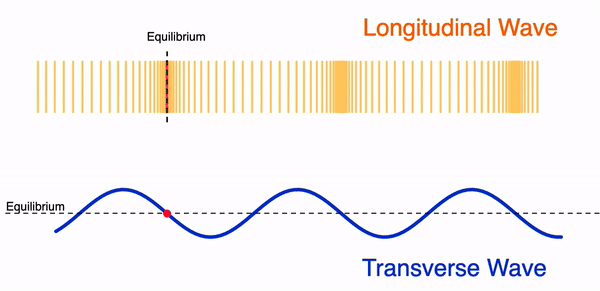The first of two apps on Phase Difference allows for interaction to demonstrate the oscillation of two different particles along the same wave with a variable phase difference.
The second shows two waves also with a phase difference.
In both cases, the phase difference $\Delta\phi$ can be calculated with
$$\Delta\phi = \dfrac{\Delta x}{\lambda} \times 2\pi$$
where $\Delta x$ is the horizontal distance between the two particles or the horizontal distance between the two adjacent identical particles (one from each wave) and $\lambda$ is the wavelength of the waves.
I modified Tom Walsh’s original GeoGebra app to add a moveable single oscillating particle for students to observe its movement along a longitudinal wave and a transverse wave.
The app can also be used to show how the displacement of a particle in a longitudinal wave can be mapped onto a sinusoidal function, similar to the shape of a transverse wave. For example. a displacement of the particle to the right can be represented by a positive displacement value on the displacement-distance graph.
You can choose to select the particle that you want to focus on by using the slider.
For a full screen view, visit https://www.geogebra.org/m/auyft2pd
Here is an animated gif for those who prefer to insert it into a powerpoint slideshow instead:

For embedding into SLS or any platform that supports iframes.
<iframe scrolling="no" title="Progressive Waves" src="https://www.geogebra.org/material/iframe/id/auyft2pd/width/640/height/480/border/888888/sfsb/true/smb/false/stb/false/stbh/false/ai/false/asb/false/sri/true/rc/false/ld/false/sdz/false/ctl/false" width="640px" height="480px" style="border:0px;"> </iframe>This GeoGebra app allows students to observe closely the movement of a particle in a progressive wave, with two possible directions of energy propagation.
In a typical question, students will be asked to predict the next movement of a particle given that a wave is moving left or right. Usually, students will need to imagine the waveform shifting slightly to the left or right in order to figure that out. This app follows the same visualisation technique to identify the subsequent movement of any particle along a wave.
This deck of slides was used today in my sharing session with some colleagues on the use of assessment features in SLS. Sharing it here for anyone who might be interested.








I used this demonstration to start a conversation about refractive index with my IP3 kids. These hydrogels certainly generated a lot of excitement as the kids were fascinated with how invisible it becomes when placed in water.
You can get a 1000 (yes, one thousand!) of these for $1.29 at Shopee. Make sure to choose the transparent ones instead of the coloured version when checking out.
Say goodbye to the messy demonstration involving the soaking of glass in a beaker of vegetable oil or glycerin.